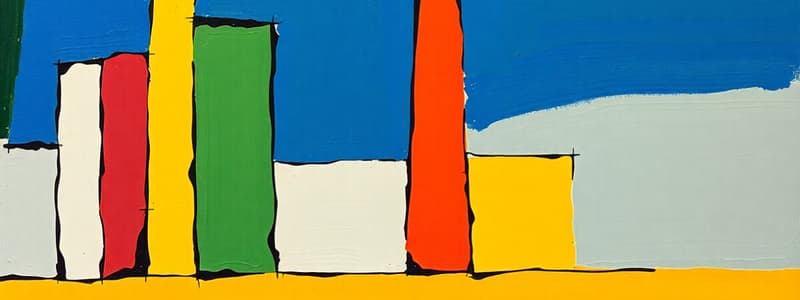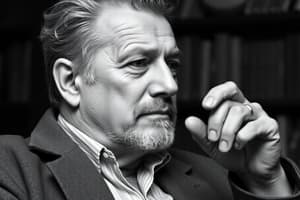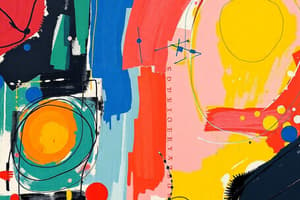Podcast
Questions and Answers
Which characteristic is LEAST aligned with the High Modernism literary period?
Which characteristic is LEAST aligned with the High Modernism literary period?
- Reaffirmation of foundational Western cultural values and beliefs. (correct)
- Reflection of the historical context and societal changes following World War I.
- Exploration of complex themes using innovative literary forms.
- Emphasis on personal mythmaking as a means of understanding the world.
What was a significant impact of World War I on literature during the Modernist period?
What was a significant impact of World War I on literature during the Modernist period?
- An increased sense of optimism and belief in societal progress.
- A renewed focus on traditional literary forms and styles.
- A questioning of established values and a sense of disillusionment. (correct)
- A strengthening of religious faith and moral certainties.
What is the primary focus of Virginia Woolf's critique of Edwardian English fiction in "Modern Fiction"?
What is the primary focus of Virginia Woolf's critique of Edwardian English fiction in "Modern Fiction"?
- Its excessive concern with spirituality over physical realities.
- Its experimental narrative techniques and disregard for traditional storytelling conventions.
- Its preoccupation with superficial aspects of life rather than inner experiences. (correct)
- Its focus on political and social issues, neglecting personal and emotional development.
How does Virginia Woolf employ contrasting characters in Mrs. Dalloway to create a 'Cubist effect'?
How does Virginia Woolf employ contrasting characters in Mrs. Dalloway to create a 'Cubist effect'?
Which statement best describes "free indirect speech" as a narrative technique?
Which statement best describes "free indirect speech" as a narrative technique?
What is the significance of the gyre metaphor in W.B. Yeats's "The Second Coming"?
What is the significance of the gyre metaphor in W.B. Yeats's "The Second Coming"?
What is the primary effect of Yeats's use of repetition in "Easter, 1916"?
What is the primary effect of Yeats's use of repetition in "Easter, 1916"?
How does T.S. Eliot view the relationship between tradition and individual talent?
How does T.S. Eliot view the relationship between tradition and individual talent?
What does T.S. Eliot's "The Waste Land" primarily symbolize?
What does T.S. Eliot's "The Waste Land" primarily symbolize?
How does T.S. Eliot employ literary tradition in "The Waste Land"?
How does T.S. Eliot employ literary tradition in "The Waste Land"?
In James Joyce's "Araby", what does the bazaar primarily represent for the young protagonist?
In James Joyce's "Araby", what does the bazaar primarily represent for the young protagonist?
What is the significance of the protagonist's ultimate experience at the Araby bazaar?
What is the significance of the protagonist's ultimate experience at the Araby bazaar?
How does the concept of "personal mythmaking" relate to the Modernist writers' response to the loss of traditional values?
How does the concept of "personal mythmaking" relate to the Modernist writers' response to the loss of traditional values?
What role did the Bloomsbury Group play in the development of Literary Modernism?
What role did the Bloomsbury Group play in the development of Literary Modernism?
Which of the following is a key characteristic of stream of consciousness narration?
Which of the following is a key characteristic of stream of consciousness narration?
Beyond its historical context, what broader theme does Yeats explore in "Easter 1916"?
Beyond its historical context, what broader theme does Yeats explore in "Easter 1916"?
What is the role of the 'catalyst' in T.S. Eliot's analogy of the poet's mind to a chemical reaction?
What is the role of the 'catalyst' in T.S. Eliot's analogy of the poet's mind to a chemical reaction?
How does James Joyce challenge the traditional concept of the 'reliable narrator' in "Araby"?
How does James Joyce challenge the traditional concept of the 'reliable narrator' in "Araby"?
Which of the following best describes the Modernist approach to realism in literature?
Which of the following best describes the Modernist approach to realism in literature?
What is the significance of the title "A Room of One's Own" in relation to Virginia Woolf's ideas about women and writing?
What is the significance of the title "A Room of One's Own" in relation to Virginia Woolf's ideas about women and writing?
Flashcards
Edwardian Period
Edwardian Period
A period in early 20th-century England, following Queen Victoria's reign. Known for a sense of transition and social change.
Bloomsbury Group
Bloomsbury Group
An upper-middle-class group in London, including writers and artists, who explored Modernism's artistic possibilities.
Free Indirect Speech
Free Indirect Speech
A type of narration that incorporates a character's language and subjectivity without explicit introduction, blending their thoughts with the narration.
Stream of Consciousness
Stream of Consciousness
Signup and view all the flashcards
Easter Rising (1916)
Easter Rising (1916)
Signup and view all the flashcards
Occasional Poem
Occasional Poem
Signup and view all the flashcards
Historical Gyres
Historical Gyres
Signup and view all the flashcards
Tradition and Individual Talent
Tradition and Individual Talent
Signup and view all the flashcards
The Waste Land
The Waste Land
Signup and view all the flashcards
Epiphany (in Joyce)
Epiphany (in Joyce)
Signup and view all the flashcards
High Modernism
High Modernism
Signup and view all the flashcards
Late Modernism
Late Modernism
Signup and view all the flashcards
Postmodernism
Postmodernism
Signup and view all the flashcards
Aestheticism
Aestheticism
Signup and view all the flashcards
Mrs Dalloway
Mrs Dalloway
Signup and view all the flashcards
Cubism
Cubism
Signup and view all the flashcards
W.B. Yeats
W.B. Yeats
Signup and view all the flashcards
Theosophy
Theosophy
Signup and view all the flashcards
Easter 1916
Easter 1916
Signup and view all the flashcards
The Wasteland
The Wasteland
Signup and view all the flashcards
Study Notes
The Twentieth Century + Modernism
- Modernism spans three periods: High Modernism (1920s), Late Modernism (1930s-1950s), and Postmodernism (1960s-??).
- High Modernism involved figures like Eliot, Joyce, Woolf, and Yeats.
- Modernism reflects a loss of foundational Western values, including religion, humanism, progress, and faith in language.
- Modernist authors used personal mythmaking, often autobiographical, reflecting the historical context.
- Modernist literature captures the complexity of life through innovative forms, open endings, and extensive use of imagery, metaphors, and symbols.
- A typical Modernist character is a lonely individual wandering through the world.
- The Edwardian period influenced Modernism with its focus on aestheticism.
- Literary market diversification occurred, increasing readership.
- World War I (1914-1918) shattered the idea of progress and spurred new ideas.
- Cities gained prominence while psychoanalysis emerged through figures like Freud, Nietzsche, Planck, and Einstein.
Virginia Woolf – Modern Fiction
- Virginia Woolf was a literary critic, essayist, and novelist who focused on the position of women in literature.
- Woolf and her husband, Leonard Woolf, ran the Hogarth Press.
- Woolf was a member of the Bloomsbury Group, which explored the artistic possibilities of Modernism.
- Literary Modernism included poetry, shorter novels, short stories, and professional literary criticism.
- Modernism saw an inward turn of narrative, employing stream of consciousness and free indirect speech.
- A Room of One’s Own discusses the requirements for women to write, imagining Shakespeare's sister.
- Modern Fiction (1919/1925) critiques Edwardian fiction's focus on the physical ("the body") over the spiritual ("the spirit").
- Woolf criticizes trivialities but contradicts herself, noting writers are still bound by literary principles.
Mrs. Dalloway – 1925
- Mrs. Dalloway is set in London and uses two parallel plotlines featuring Clarissa Dalloway and Septimus Warren Smith.
- The novel uses a cubist effect by contrasting the two protagonists.
- Mrs. Dalloway employs free indirect speech and stream of consciousness narration.
- Cubism in literature involves contrasting different minds
- Free indirect speech incorporates a character's language and subjectivity without explicit introduction or shifts in pronouns and tense.
- Stream of consciousness narration represents the continuous flow of perceptions, thoughts, feelings, and memories in the mind.
- Woolf believed Edwardian authors were too perfect, and literature requires "cracks" to let life in.
W.B. Yeats – Easter 1916 / The Second Coming
- W.B. Yeats won the Nobel Prize in 1923 and drew on Irish folklore and history for his work.
- Yeats' style evolved, influenced by his belief in magic, the occult, and theosophy.
- Yeats used personal mythmaking to create meaning due to a perceived loss of religion.
- "Easter 1916" addresses the Easter Rising of 1916, where Irish republicans rebelled against British rule in Dublin.
- The poem is an occasional poem engaging with a contemporary event.
- The poem shifts from personal reflections to universal themes, showing respect and rejection, and ends with an attempt at impartiality.
- The poem uses repetition, resembling a lullaby.
The Second Coming – 1920/21
- "The Second Coming" describes a world where "things fall apart; the centre cannot hold," using the metaphor of a gyre.
- History is presented as a system of gyres in contrast with each other.
- The poem has an apocalyptic tone, emphasizing uncertainty and change.
- Humans lose control over their environment.
- Instead of Jesus, a mysterious entity comes to save the world.
T.S. Eliot – The Waste Land
- T.S. Eliot was a poet, critic, editor, and Nobel laureate (1948).
- His essay "Tradition and the Individual Talent" (1919) advocates understanding poetry through tradition and analogy to science.
- Eliot emphasized the importance of tradition for writers to achieve modernity.
- Eliot compared the poet's mind to a catalyst in a chemical reaction, combining elements from tradition.
The Waste Land – 1922
- The Waste Land alludes to Chaucer’s The Canterbury Tales.
- The Waste Land explores brokenness, isolation, and generational trauma after the war.
- The "waste land" is a metaphor for modern society without values.
- The poem references the idea of rebirth.
- The poem is experimental in form, using free verse and fragmented structure incorporating dialogue.
James Joyce – Araby - 1914
- James Joyce was an Irish cosmopolitan novelist known for controversial subjects and innovative narrative forms.
- Dubliners was published in 1914.
- "Araby" features autobiographical details of a boy going to a market to buy something for a girl.
- The story is a coming-of-age tale with an unreliable narrator.
- The protagonist experiences a moment of realization and epiphany.
- The story has Catholic connotations, such as the boy attending Catholic school and his view of romance as a replacement for religion.
- The story shows a broader sense of loss of values and narratives.
- While based on a heroic quest, the story ends with frustration instead of fulfillment.
- Religion lacks meaning, and the bazaar symbolizes imperialism.
- The story features fragmentary experiences of reality.
- Modernist literature reflects reality, embracing realism.
Studying That Suits You
Use AI to generate personalized quizzes and flashcards to suit your learning preferences.




